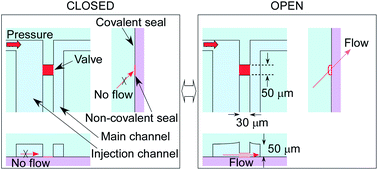Simple bilayer on-chip valves using reversible sealability of PDMS
Abstract
Valves are the most important components of lab-on-a-chip systems for the manipulation of small-volume samples. Various types of valves have been developed, but most of them require external actuators or complicated control lines (displacement chambers) to deform microchannels for valve functionalization. The development of a simple microfluidic valve has thus far been quite a technical challenge. Herein is presented the development of a simple, normally-closed passive valve on a microchip using a new patterning technique involving oxygen plasma with aluminum sacrificial lines, where surface activation is not induced. Only the valve sections are inactivated which produces a non-covalent, reversible seal between the polydimethylsiloxane (PDMS) lid and the glass substrate. When a fluid pressure in excess of the burst pressure is applied to this non-covalent seal area, the PDMS detaches slightly from the glass so that the fluid can pass through. Valve function was demonstrated by observation of the microchannels with a fluorescence microscope. A fluorescent dye was injected through the valve, and the burst pressure was measured to be 20 kPa. The opened valve was calculated to have a 2.1 μm gap (maximum) via the Hagen–Poiseuille law. Injection from multiple channels was also demonstrated, and the burst pressure did not change significantly over 6 injection cycles. This extremely simple structure can be utilized practically as an easy-to-implement and back-flow-free check valve, so long as the pressure in the outlet channel does not exceed the burst pressure threshold.


 Please wait while we load your content...
Please wait while we load your content...